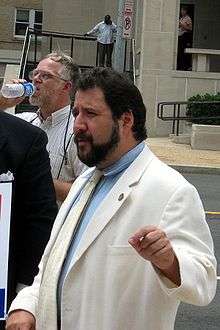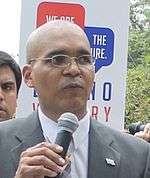Shadow congressperson
The offices of shadow U.S. Representative and shadow U.S. Senator are elective offices in the District of Columbia. While the holders of these offices are not seated in either house of the United States Congress, they promote the District's efforts to gain full voting rights. Historically, shadow congressmen were elected by organized incorporated territories prior to their admission to the Union.[1]
The first shadow senators, William Blount and William Cocke of the Southwest Territory, were elected in March 1796, before being seated as senators representing the newly formed state of Tennessee. Michigan, California, Minnesota, Oregon, and Alaska likewise elected shadow senators before statehood. The Alaska Territory also elected the first shadow U.S. Representative, Ralph Julian Rivers, in 1956. All were eventually seated in Congress as voting members, except for Alaska Shadow Sen. William A. Egan, who instead became governor.[1] The election of shadow congresspersons from the District of Columbia is authorized by a "state" constitution, which was ratified by D.C. voters in 1982 but was never approved by Congress.[2]
Current District of Columbia officeholders
Shadow Senator
The voters of the District of Columbia elect two shadow U.S. Senators who are known as U.S. Senators by the District of Columbia, but who are not officially sworn or seated by the U.S. Senate. Shadow senators were first elected in 1990.
The current shadow senators are Paul Strauss and Michael Donald Brown.[3]
List of District of Columbia Senators (Seat 1)
| # | Image | Senator | Term start | Term end | Party | Notes |
|---|---|---|---|---|---|---|
| 1 |  |
Florence Pendleton (born 1926) |
January 3, 1991 | January 3, 2007 | Democratic | Elected in 1990, 1994, and 2000. Ran for reelection in 2006 but lost. |
| 2 | .jpg) |
Michael D. Brown (born 1953) |
January 3, 2007 | Incumbent | Independent Democratic (before 2014) |
Elected in 2006 and 2012. |
List of District of Columbia Senators (Seat 2)
| # | Image | Senator | Term start | Term end | Party | Notes |
|---|---|---|---|---|---|---|
| 1 |  |
Jesse Jackson (born 1941) |
January 3, 1991 | January 3, 1997 | Democratic | Elected in 1990. |
| 2 |  |
Paul Strauss (born 1964) |
January 3, 1997 | Incumbent | Democratic | Elected in 1996, 2002, 2008, and 2014. |
Shadow Representative
The voters of the District of Columbia elect one Shadow Representative who is recognized as equivalent to U.S. Representatives by the District of Columbia, but is not recognized by the U.S. government as an actual member of the House of Representatives. A shadow representative was first elected in 1990. The current shadow representative is Franklin Garcia.
DC's Shadow U.S. Representative should not be confused with the non-voting delegate who represents the District in Congress.
List of District of Columbia Shadow U.S. Representatives
- Charles Moreland (D), 1991–1995
- John Capozzi, Jr. (D), 1995–1997
- Sabrina Sojourner (D), 1997–1999
- Tom Bryant, Jr. (D), 1999–2001
- Ray Browne (D), 2001–2007[4]
- Mike Panetta (D), 2007–2013
- Nate Bennett-Fleming (D), 2013–2015
- Franklin Garcia (D), 2015–present[5][6]
See also
References
- 1 2 Strauss, Paul. "A Brief History of the Shadow Senators of the United States". Paul Strauss – United States Senator for the District of Columbia. Archived from the original on February 11, 2003.
- ↑ Sheridan, Mary Beth (2008-05-29). "D.C. Seeks to Fund Lobbying Effort for a Voting House Member". The Washington Post. p. B01. Retrieved 2008-12-29.
- ↑ Election profiles Michael D. Brown (D), The Washington Post, 2006, retrieved, September 30, 2012.
- ↑ Sullivan, Patricia (February 18, 2010). "Ray Browne, fought for D.C. voting rights, dies at 71". The Washington Post.
- ↑ "District of Columbia Election Results". New York Times. Dec 17, 2014.
- ↑ "Franklin for DC". Franklin Garcia for DC. Jan 2, 2015.
External links
- A Brief History of the Shadow Senators of the United States
- Washington Post article on shadow delegation
- Official Site of District of Columbia
- Shadow Congressional Representatives contact information
